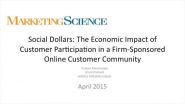New climate projections paint bleak future for tropical coral reefs
2015-05-04
(Press-News.org) ITHACA, N.Y. - As greater atmospheric carbon dioxide boosts sea temperatures, tropical corals face a bleak future. New climate model projections show that conditions are likely to increase the frequency and severity of coral disease outbreaks, reports a team of researchers led by Cornell University scientists, published today (May 4) in Nature Climate Change.
Download study, FAQ and photos: https://cornell.box.com/coral-disease
Conserving coral reefs is crucial to maintaining the biodiversity of our oceans and sustaining the livelihoods of the 500 million people that depend on coral reefs. Coral reefs are also important to the global economy, as the U.S. National Oceanic and Atmospheric Administration estimates the world's coral reef systems are worth about $30 billion annually.
In the agricultural world, scientists have been modeling disease risk and outbreak timing with weather for decades. However, these new model outputs of future conditions on reefs are the first to examine how expected changes in climate affect the risk of diseases among wildlife in the marine environment. The research team also compares their model outputs for coral disease with expected future changes in the more widely publicized impact of coral bleaching.
"Perhaps more than any findings to date, these results indicate that increases in the prevalence and severity of coral diseases will be a major future driver of decline and changes in coral reef community composition, and at least as great a driver as coral bleaching," said Jeffrey Maynard, a postdoctoral researcher in ecology and evolutionary biology and lead author of "Projections of Climate Conditions That Increase Coral Disease Susceptibility and Pathogen Virulence."
Warmer conditions increase the susceptibility of corals to the pathogens that cause disease and increase pathogen abundance and virulence. The climate stress compounds the strain caused by human activities near reefs, such as marine pollution, sedimentation caused by coastal development and overfishing. The research team examined the implications of both of these types of stress to corals to produce global maps of disease risk. Coral reef managers and policymakers now can use these maps to target actions to reduce stress on coral reefs and to test approaches to reduce disease impact. "This is the first attempt to project the effects of synergism between climate and human-related stressors on risk of coral disease," said senior author Drew Harvell, Cornell professor of ecology and evolutionary biology.
The scientists say that the likely future impact of coral disease on coral reef community composition and condition so far has been underappreciated, which they hope to change by publishing this scientific paper.
There are many areas where disease causes more coral mortality than coral bleaching. For this reason, Maynard and the other scientists suggest warning systems be built into coral disease response plans to help conservationists and managers reduce disease impacts. "To develop these warning systems, there is a vital need to expand upon the current, limited suite of tools that forecast conditions conducive to coral disease outbreaks. This paper is a start in that direction," said Maynard.
INFORMATION:
The NOAA Climate Program Office and National Science Foundation funded the study.
ELSE PRESS RELEASES FROM THIS DATE:
2015-05-04
A new study published in Marketing Science, a journal of the Institute for Operations Research and the Management Sciences (INFORMS), shows double-digit revenue growth for firms that create their own brand-specific online communities.
The study, Social Dollars: The Economic Impact of Customer Participation in a Firm-Sponsored Online Customer Community, is by professors Puneet Manchanda of the University of Michigan, Grant Packard of Wilfrid Laurier University, and Adithya Pattabhiramaiah of the Georgia Institute of Technology.
Engaging consumers through online social ...
2015-05-04
Nerves aren't known for being stretchy. In fact, "nerve stretch injury" is a common form of trauma in humans. But researchers reporting in the Cell Press journal Current Biology on May 4 have discovered that nerves in the mouths and tongues of rorqual whales can more than double their length with no trouble at all.
"These large nerves actually stretch and recoil like bungee cords," says A. Wayne Vogl of the University of British Columbia. "This is unlike other nerves in vertebrates, where the nerve is of a more fixed length that has enough slack in it to accommodate changes ...
2015-05-04
University of British Columbia (UBC) researchers have discovered a unique nerve structure in the mouth and tongue of rorqual whales that can double in length and then recoil like a bungee cord.
The stretchy nerves explain how the massive whales are able to balloon an immense pocket between their body wall and overlying blubber to capture prey during feeding dives.
"This discovery was totally unexpected and unlike other nerve structures we've seen in vertebrates, which are of a more fixed length," says Wayne Vogl of UBC's Cellular and Physiological Sciences department.
"The ...
2015-05-04
BOSTON, MA - The Emergency Department (ED) is at the convergence of the opioid epidemic as emergency physicians (EPs) routinely care for patients with adverse effects from opioids, including overdoses and those battling addiction, as well as treating patients that benefit from opioid use. Increasingly, EPs are required to distinguish between patients who are suffering from a condition that warrants opioids to relieve pain, and those who may be attempting to obtain these medications for other purposes, such as abuse or diversion. Overall, opioid pain reliever prescribing ...
2015-05-04
(MEMPHIS, Tenn. -- May 4, 2015) Researchers led by St. Jude Children's Research Hospital scientists have identified a mechanism that helps leukemia cells resist glucocorticoids, a finding that lays the foundation for more effective treatment of cancer and possibly a host of autoimmune diseases. The findings appear online today in the scientific journal Nature Genetics.
The research focused on glucocorticoids, a class of steroid hormones. These hormones have been key ingredients in the chemotherapy cocktail that has helped to push long-term survival for the most common ...
2015-05-04
(MEMPHIS, Tenn. - May 4, 2015) St. Jude Children's Research Hospital scientists have developed a significantly better computer tool for finding genetic alterations that play an important role in many cancers but were difficult to identify with whole-genome sequencing. The findings appear today in the scientific journal Nature Methods.
The tool is an algorithm called CONSERTING, short for Copy Number Segmentation by Regression Tree in Next Generation Sequencing.
St. Jude researchers created CONSERTING to improve identification of copy number alterations (CNAs) in the ...
2015-05-04
COLUMBIA, Mo. -- Within the knee, two specialized, C-shaped pads of tissue called menisci perform many functions that are critical to knee-joint health. The menisci, best known as the shock absorbers in the knee, help disperse pressure, reduce friction and nourish the knee. Now, new research from the University of Missouri shows even small changes in the menisci can hinder their ability to perform critical knee functions. The research could provide new approaches to preventing and treating meniscal injuries as well as clues to understanding osteoarthritis; meniscal problems ...
2015-05-04
(New York -- May 4, 2015) Icahn School of Medicine at Mount Sinai researchers presented several landmark studies at the 2015 American Association for Thoracic Surgery (AATS) meeting in Seattle.
AATS Highlights include:
First Successful 3D Printed Trachea
A team of researchers from Icahn School of Medicine have combined 3D printing technology with human stem cells to create the first successful 3D-printed biologic tracheal graft in an animal model. Using a biocompatible polymer, researchers created a customized 3D-printed tracheal graft seeded with stem cells. The ...
2015-05-04
CORVALLIS, Ore. - The decline of the world's large herbivores, especially in Africa and parts of Asia, is raising the specter of an "empty landscape" in some of the most diverse ecosystems on the planet, according to a newly published study.
Many populations of animals such as rhinoceroses, zebras, camels, elephants and tapirs are diminishing or threatened with extinction in grasslands, savannahs, deserts and forests, scientists say.
An international team of wildlife ecologists led by William Ripple, Oregon State University distinguished professor in the College of ...
2015-05-04
Scientists have created microbe-sized beads that can utilize energy in the environment to self-propel upstream by purely physical means.
Life is hard to define, but metabolism, mobility and replication are three commonly agreed elements. The beads are not alive, but they meet two of these three requirements.
"Living systems change their behavior according to their environment," said Jeremie Palacci, a professor of physics at the University of California, San Diego. "So the question was, can we design a particle that can sense its environment with no neural system or ...
LAST 30 PRESS RELEASES:
[Press-News.org] New climate projections paint bleak future for tropical coral reefs




